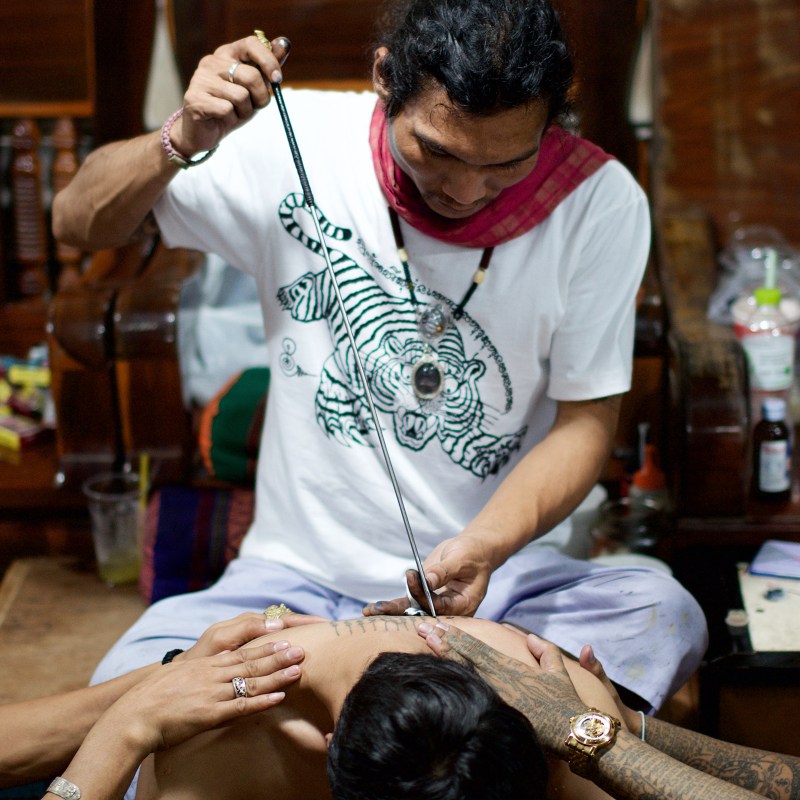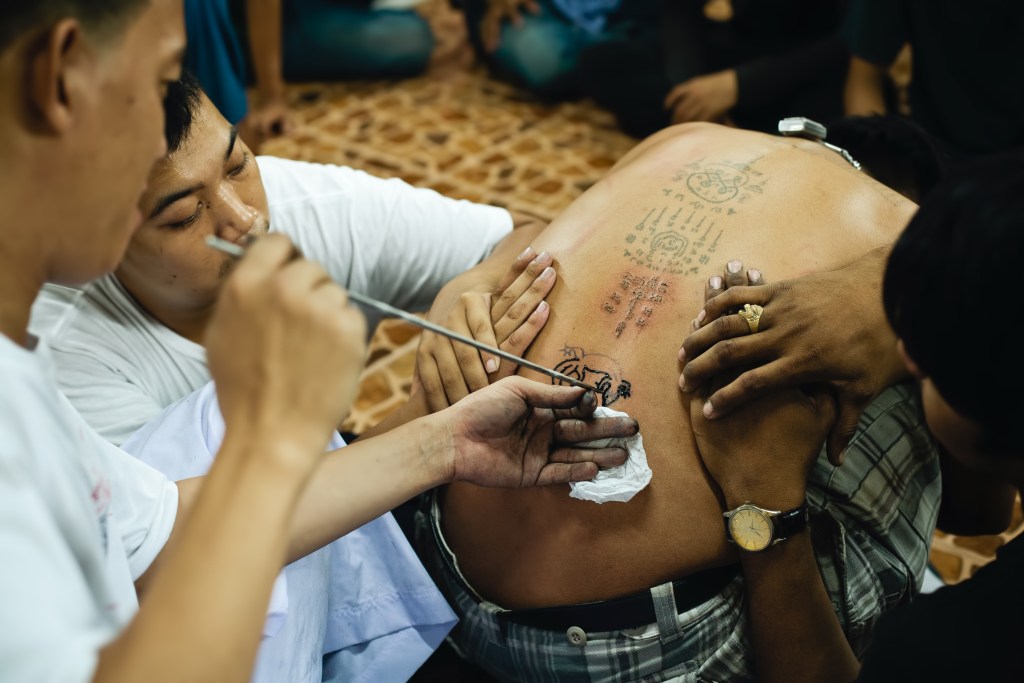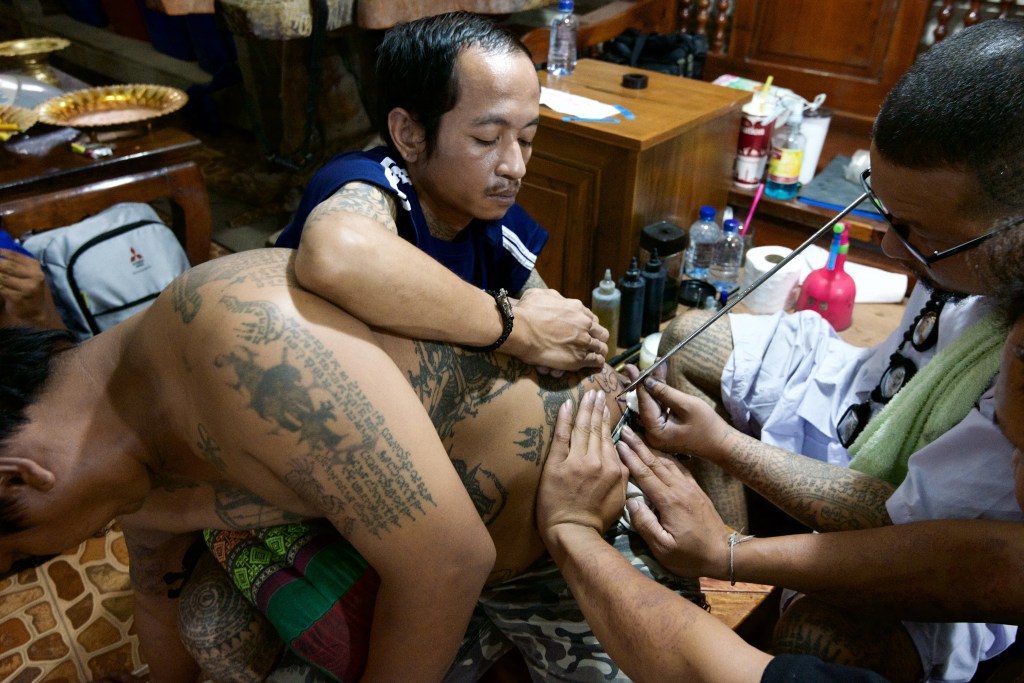
If you were following pop culture even half-heartedly in the mid-2000s, you probably remember Angelina Jolie’s adventures in Southeast Asia.
Videos by TravelAwaits
During one of her most famous photo ops, the actress flew a sak yant tattoo master from Bangkok, Thailand, to Cambodia, where she was filming at the time. The master, named Ajarn Noo Kanpai, tattooed Jolie in a photo that would hit global headlines.
The image of the old-school stick-and-poke tattoo session sparked curiosity and intrigue for millions of Americans.
What are stick-and-poke tattoos? What does the curling, elegant script mean? And why was Jolie in a meditative pose during the tattoo session?
It fueled interest in Thailand, and even helped put Thailand ‘on the map’ for Americans. Those who knew little about the Land of Smiles suddenly had a reason to learn more.
I was one of these intrigued parties.
Cut to me sitting in my living room, rifling through a People magazine and reading about Jolie, Southeast Asia, and sank yant.
It sparked curiosity in me, piggybacking on other pop culture sensations like No Reservations.
Cut to ten years after that, when I was a college student in Thailand and had the chance to study sak yant (sometimes called yantra tattooing). And not just vaguely, but with a qualified translator who would introduce me to sak yant masters in Chiang Mai and in the surrounding areas.
Here’s what I learned. Also, here’s how I accidentally got tattooed.
Sak Yant tattoos in Thailand: the basics

Back in 2014, I was studying in Chiang Mai as part of my Global Studies coursework. Every semester, we were in charge of organizing and completing an independent study project, aka lone research out in the field.
I teamed up with a local translator named Man, who would help me find and interview sak yant tattoo artists. My goal: figure out whether it was acceptable for tourists and travelers like me to get traditional sak yant tattoos.
Here’s a crash course based on what I learned interviewing tattoo artists in Chiang Mai and the surrounding area. (If you want to learn more, I suggest diving into Sak Yant Chiang Mai—their website is great.)
First, sak yant is a ‘spiritual’ tattoo in that the designs, symbols, and arrangement of the tattoo will imbue the receiver with spiritual power. These symbols come from a time when Southeast Asia was Hindu, so you might notice some motifs that look similar to Hinduism.
This spiritual power is created and dispensed by the tattoo master, who will work with the recipient to ensure they receive the right tattoo. In other words, a tattoo isn’t just for show; it’s considered to have spiritual power that will have a direct impact on the recipient’s life and wellbeing.
Second, there are three ways you can get a sak yant tattoo. You can receive one from a Buddhist master who is also a monk and has learned the Buddhist forms of sak yant; you can receive one from a ‘rishi’ or spiritual master who works within the animist and folk religion realms; or you can receive one from a commercial tattoo artist.
It’s important to note that a commercial tattoo artist does not have the spiritual qualifications to imbue the tattoo with power. It’s just a design that’s for show, in other words.
On the other hand, sak yant tattoos in Thailand that come from Buddhist masters or rishis have spiritual power.
You’ll notice that many sak yant designs are in a grid pattern and/or include animals.
The grid pattern can be viewed as a type of ‘spiritual formula’; the sak yant master is creating a combination of symbols, words, concepts, and/or ideas that ensure specific results, like luck, bravery, or compassion.
You’ll notice that muay Thai fighters often have animals tattooed. These are a formidable form of sak yant, as the tattoo master is imbuing the recipient with the spiritual energy of the animal.
Tigers, for example, aren’t a common sak yant because the recipient must be able to wield and channel the tiger’s great power. It could ‘corrupt’ a recipient who isn’t disciplined enough to handle the power.
Very cool, right?
Can tourists get sak yant tattoos in Thailand?
Like I mentioned up top, the point in studying sak yant was to answer whether or not it was okay for tourists and travelers like me to receive them.
The short answer: yes.
Every tattoo artist, whether a commercial artist or a true sak yant master, has the autonomy to choose whether or not to tattoo someone. The power to decide who receives and doesn’t receive a sak yant falls down to the master in question; if they approve, that’s that.
I also want to point out that many sak yant tattoos come with conditions. The recipient must fulfill certain responsibilities to be worthy of the tattoo’s power.
When I received my sak yant tattoo (more on this below), I was instructed that the tattoo would only maintain its power if I agreed to honor my parents.
So, it’s possible that someone could receive a spiritual blessing in the form of sak yant, then squander it with poor behavior. Again, very cool.
How can you get a Sak Yant tattoo in Thailand on your trip?

There are dozens of ways for you to get a sak yant tattoo in Thailand—but you need to dig deep if you want to ensure you’re receiving one from a spiritual master. If you just want the design, you can find it pretty easily at a commercial tattoo studio.
If not, I highly suggest hiring a translator, like I did. It will be really helpful if you plan on staying in a highly touristy zone like Bangkok or Koh Samui. However, if you’re heading more into ‘backpacker territory’ in Chiang Mai, you should have an easier time finding a sak yant master.
Lastly, I suggest sticking with Buddhist sak yant masters. The rishi I visited and interviewed was very respectful and helpful, but because he was working more in the domain of folk beliefs and religion, I had a harder time understanding his work.
Think of the difference like visiting a doctor versus a practitioner of traditional medicine; both are perfectly qualified and useful in their respective domains, but if you’ve never dipped a toe into the realm of traditional medicine, you might feel nervous and uncertain about the practices and science involved.
My sak yant tattoo story
For a few weeks, I’d been zipping around the countryside on the back of my translator’s moto to interview a few different sak yant masters and tattoo artists. I decided that I wanted to ask for a sak yant tattoo from the Buddhist master who I’d already interviewed, but decided that I would only ask for the blessing rather than a permanent tattoo.
Sak yant tattoos can be ‘tattooed’ using oil, meaning you receive the full spiritual blessing of the tattoo without the ink that makes it visible. Usually, the herbal ink dissolves in a few days.
So, my translator and I headed back to the sak yant master and asked for an appropriate blessing for me. I received a basic tattoo revolving around the Buddhist concept of ‘meta’ or loving kindness/compassion. The tattoo will help attract compassion, and also help me give compassion to others—so long as I respect my parents.
I received the tattoo, then we left the grounds. The tattoo had been inked in a dark color, which I assumed was the herbal ink. I kept asking my translator, “It will be clear, right?” And he kept nodding, insisting, “It will be very clear.”
He thought I meant the clarity of the script, which would be clearly visible.
I had been using the word clear the other way—as in, it would be crystal clear or invisible.
That was my bad. I will never forget the way Man’s face dropped when we realized the miscommunication. We laughed it off in no time, and I still have the sak yant tattoo.
